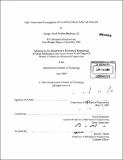| dc.contributor.advisor | Tonio Buonassisi. | en_US |
| dc.contributor.author | Hudelson, George David Stephen, III | en_US |
| dc.contributor.other | Massachusetts Institute of Technology. Dept. of Mechanical Engineering. | en_US |
| dc.date.accessioned | 2010-01-07T20:54:28Z | |
| dc.date.available | 2010-01-07T20:54:28Z | |
| dc.date.copyright | 2009 | en_US |
| dc.date.issued | 2009 | en_US |
| dc.identifier.uri | http://hdl.handle.net/1721.1/50568 | |
| dc.description | Thesis (S.M.)--Massachusetts Institute of Technology, Dept. of Mechanical Engineering, 2009. | en_US |
| dc.description | Includes bibliographical references (p. 74-78). | en_US |
| dc.description.abstract | Crystalline silicon solar cells are a promising candidate to provide a sustainable, clean energy source for the future. In order to bring about widespread adoption of solar cells, much work is needed to reduce their cost. Herein, I discuss the development of a new experimental technique to investigate solar cell materials under simulated processing conditions. I present the first applications and results using this technique, including observations of novel impurity interactions at elevated temperatures, and discuss their importance to the solar cell manufacturing process. One of the key drivers for reducing solar cell cost is developing a fundamental understanding of the behavior of defect and impurities in solar cell materials. Since solar cell processing occurs at high temperatures, experiments are needed that allow characterization of solar cell materials at high temperatures representative of manufacturing conditions, at the length-scales of the defects that are present. To achieve this, I have developed a novel in situ high temperature sample stage for measuring samples via synchrotron-based X-ray microprobe. This technique allows for mapping and chemical state determination of metal impurity clusters on the order of 100 nm to 100 [mu]m, over sample areas of several square millimeters, at temperatures in excess of 1200°C and under controlled ambient atmosphere. The application of this technique has yielded novel insights concerning the behavior of metal impurities at high temperature. | en_US |
| dc.description.abstract | (cont.) For the first time, the phenomenon of retrograde melting (i.e. melting on cooling) has been observed in a semiconductor material. Internal gettering of dissolved metal to liquid metal-silicon droplets within the silicon matrix is observed. Understanding of this phenomenon provides the potential to improve solar cell devices by reducing the more-detrimental dissolved metal content within the material by concentrating it into precipitates. Finally, I provide results and a model that explains the formation and resulting morphology of mixed-metal silicide precipitates in multicrystalline silicon. | en_US |
| dc.description.statementofresponsibility | by George David Stephen Hudelson, III. | en_US |
| dc.format.extent | 78 p. | en_US |
| dc.language.iso | eng | en_US |
| dc.publisher | Massachusetts Institute of Technology | en_US |
| dc.rights | M.I.T. theses are protected by
copyright. They may be viewed from this source for any purpose, but
reproduction or distribution in any format is prohibited without written
permission. See provided URL for inquiries about permission. | en_US |
| dc.rights.uri | http://dspace.mit.edu/handle/1721.1/7582 | en_US |
| dc.subject | Mechanical Engineering. | en_US |
| dc.title | High temperature investigations of crystalline silicon solar cell materials | en_US |
| dc.type | Thesis | en_US |
| dc.description.degree | S.M. | en_US |
| dc.contributor.department | Massachusetts Institute of Technology. Department of Mechanical Engineering | |
| dc.identifier.oclc | 464218467 | en_US |
